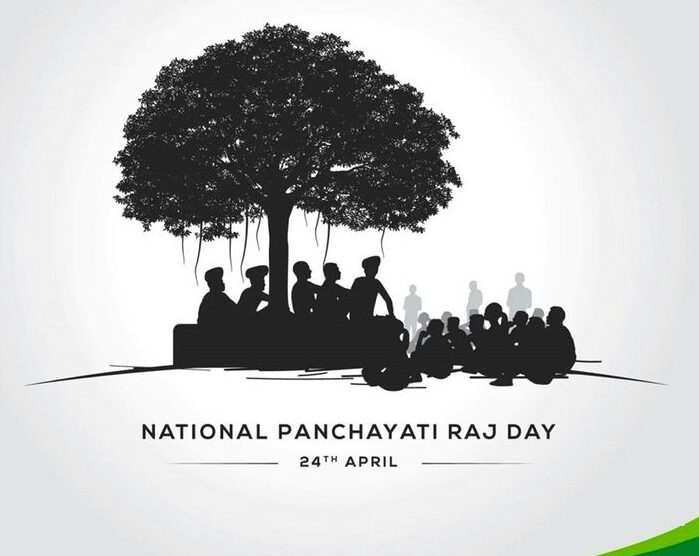🏡 7 Powerful Truths Behind National Panchayati Raj Day That Inspire Rural Upliftment
🪔 Introduction: Celebrating the Soul of India’s Grassroots Democracy
India’s true strength lies in its villages, and Panchayati Raj is the beating heart of rural governance. National Panchayati Raj Day, observed every year on April 24, celebrates the institutionalization of democracy at the grassroots level.
- 🪔 Introduction: Celebrating the Soul of India’s Grassroots Democracy
- 🏛️ History of National Panchayati Raj Day
- 📅 Timeline of Key Events
- 📌 Important Facts About Panchayati Raj
- 🤔 FAQs: All You Need to Know
- Q1: When is National Panchayati Raj Day celebrated?
- Q2: Why was this date chosen?
- Q3: What does the 73rd Amendment ensure?
- Q4: What is the role of Panchayats?
- Q5: Are Panchayats only for rural areas?
- 🌟 7 Powerful Reasons Why National Panchayati Raj Day Matters
- 1️⃣ Empowering Local Democracy
- 2️⃣ Inclusive Participation
- 3️⃣ Efficient Local Development
- 4️⃣ Direct Accountability
- 5️⃣ Fostering Women Leadership
- 6️⃣ Training Grounds for Future Leaders
- 7️⃣ Boosts Transparency & Digitization
- 🌾 How India Observes National Panchayati Raj Day
- 🙌 Wishing Messages for National Panchayati Raj Day
- 🧠 Daily Life Impacts of Panchayati Raj in India
- 🔑 Important Highlights
- 🧭 Significance in Life and Society
- 🏁 Conclusion: Building the Nation From the Ground Up
It marks the constitutional empowerment of village-level self-governance, where decisions are made by the people, for the people, and with the people.
This day is more than just a commemoration—it’s a reflection of participatory democracy, empowerment, and inclusive development.
🏛️ History of National Panchayati Raj Day
🔹 How it Began
The 73rd Constitutional Amendment Act, passed in 1992, laid the foundation for a three-tier Panchayati Raj system in India.
This act came into force on April 24, 1993, hence this day was chosen to honor the decentralization of power.
National Panchayati Raj Day was officially declared by the Government of India in 2010, under the leadership of then-Prime Minister Dr. Manmohan Singh.
📅 Timeline of Key Events
| Year | Event |
|---|---|
| 1959 | First Panchayati Raj system launched in Nagaur, Rajasthan by PM Nehru |
| 1992 | 73rd Constitutional Amendment passed |
| 1993 | Law enacted on April 24, mandating Panchayati Raj across India |
| 2009 | 11th Finance Commission emphasizes fund devolution to Panchayats |
| 2010 | First observance of National Panchayati Raj Day |
| 2020–2025 | Digital India Mission pushes e-Gram Swaraj, e-governance in Panchayats |
📌 Important Facts About Panchayati Raj
🏡 Panchayati Raj literally means rule by village committees.
🏛️ It operates at three levels: Gram Panchayat, Block (Intermediate) Panchayat, and Zila Parishad.
👩🌾 Over 2.6 lakh Panchayats exist in India.
👩🎓 One-third of seats in Panchayats are reserved for women, promoting gender inclusion.
💻 Programs like e-GramSwaraj are digitizing Panchayat operations.
💬 The Gram Sabha is a vital forum where villagers participate directly in decisions.
📈 Panchayats manage development in health, education, roads, water, sanitation, agriculture, and more.
🤔 FAQs: All You Need to Know
Q1: When is National Panchayati Raj Day celebrated?
🗓️ April 24 every year.
Q2: Why was this date chosen?
It marks the day the 73rd Amendment came into effect in 1993.
Q3: What does the 73rd Amendment ensure?
It grants constitutional status to Panchayati Raj Institutions (PRIs) and defines their structure, powers, elections, and funding.
Q4: What is the role of Panchayats?
They plan and implement development schemes, handle local infrastructure, and ensure citizen participation.
Q5: Are Panchayats only for rural areas?
Yes, Panchayati Raj applies to rural India. Urban areas have municipal bodies.
🌟 7 Powerful Reasons Why National Panchayati Raj Day Matters
1️⃣ Empowering Local Democracy
Panchayati Raj is the purest form of democracy. It brings governance to the doorsteps of the common man and bridges the gap between government and citizens.
2️⃣ Inclusive Participation
With reservations for SC/ST and women, Panchayats ensure inclusive representation and leadership for marginalized communities.
3️⃣ Efficient Local Development
From roads to schools to health centers, Panchayats understand local needs best and deliver more effective grassroots solutions.
4️⃣ Direct Accountability
Elected village representatives are answerable directly to the community, unlike distant bureaucrats.
5️⃣ Fostering Women Leadership
India has over 1 million elected women representatives in Panchayats—among the highest in the world. It nurtures confidence, skills, and leadership among women.
6️⃣ Training Grounds for Future Leaders
Many state and national leaders start their political careers in Panchayats, making it a nursery for leadership.
7️⃣ Boosts Transparency & Digitization
With initiatives like e-GramSwaraj, GPDP (Gram Panchayat Development Plan), and AuditOnline, Panchayats are becoming tech-savvy and transparent.
🌾 How India Observes National Panchayati Raj Day
🎤 National Level
The Ministry of Panchayati Raj holds a national conference.
Awards like Nanaji Deshmukh Rashtriya Gaurav Gram Sabha Puraskar are given for best-performing Panchayats.
PM or President may deliver keynote speeches promoting Gram Swaraj.
🏡 Local Level
Gram Sabhas are held in thousands of villages to:
Review development work
Present annual reports
Discuss community needs
Pass resolutions
Awareness drives about government schemes and rights are conducted.
🙌 Wishing Messages for National Panchayati Raj Day
🎉 “On this National Panchayati Raj Day, let’s salute our grassroots leaders who build the nation from the roots up.”
🌱 “True democracy begins in the village. Happy Panchayati Raj Day!”
👩🌾 “Let’s empower every gram sabha, every villager, every voice. Wishing you a meaningful Panchayati Raj Day!”
📢 “A strong nation starts with strong Panchayats. Celebrate self-governance today!”
🧠 Daily Life Impacts of Panchayati Raj in India
🏫 Schools in villages are built and managed by Panchayats.
🚰 Clean water supply often depends on Panchayat-managed infrastructure.
🌿 Sanitation, cleanliness drives, and toilets are part of Panchayat plans.
🧑⚕️ Primary health centers are usually planned and monitored locally.
🛣️ Local roads, lighting, and drainage are direct outputs of Panchayat projects.
📋 Welfare schemes (PMAY, MGNREGA) are implemented with Panchayat support.
📱 Grievance redressal and public hearings make leaders more accessible.
🔑 Important Highlights
📅 Date: April 24
📜 Established by: 73rd Constitutional Amendment Act
🏛️ Announced in: 2010
📍 Applies to: Rural India only
👩🌾 Seats Reserved for Women: 33% (some states have 50%)
💡 Major Programs: e-Gram Swaraj, GPDP, AuditOnline
🧭 Significance in Life and Society
The Panchayati Raj system:
Strengthens the foundation of democracy
Promotes self-reliance in rural India
Encourages bottom-up planning
Gives voice to the voiceless and underserved
Increases civic engagement and social inclusion
Inspires local leadership, development, and innovation
It’s not just a governance model—it’s a movement for change, led by villagers, for villagers.
🏁 Conclusion: Building the Nation From the Ground Up
National Panchayati Raj Day is not just about a law passed in 1993. It’s about the power of people, the spirit of self-governance, and the vision of an inclusive India where development is decentralized, demand-driven, and democratic.
Villages are not the periphery—they are the center of India’s soul. Empowering Panchayats means empowering India.
As we celebrate this important day, let us honor the sarpanches, ward members, and village volunteers who work relentlessly to make every rural home a place of dignity, growth, and opportunity.









ремонт кофемашин melitta ремонт кофемашин delonghi в москве
консультация юриста бесплатная консультация адвоката без регистрации
Нужен вентилируемый фасад: подсистемы для навесных вентилируемых фасадов
Нужны пластиковые окна: пластиковые окна цена метр
shipping services new york shipping to florida from new york
trucking in nyc nyc shipping
оценка ООО для нотариуса оценочные фирмы
vps host vps hosting
столик косметолога лампа лупа косметологическая купить
доставка бетона саратов заказать бетон
Цены на ремонт https://remontkomand.kz/ru/price квартир и помещений в Алматы под ключ. Узнайте точные расценки на все виды работ — от демонтажа до чистовой отделки. Посчитайте стоимость своего ремонта заранее и убедитесь в нашей прозрачности. Никаких «сюрпризов» в итоговой смете!
Планируете ремонт https://remontkomand.kz в Алматы и боитесь скрытых платежей? Опубликовали полный и честный прайс-лист! Узнайте точные расценки на все виды работ — от демонтажа до чистовой отделки. Посчитайте стоимость своего ремонта заранее и убедитесь в нашей прозрачности. Никаких «сюрпризов» в итоговой смете!
Нужен клининг? топ клининговых компаний москвы 2026. Лучшие сервисы уборки квартир, домов и офисов. Сравнение услуг, цен и отзывов, чтобы выбрать надежного подрядчика.
swot анализ компании swot анализ бизнеса
Want to have fun? melbet drugs Watch porn, buy heroin or ecstasy. Pick up whores or buy marijuana. Come in, we’re waiting
Новые актуальные промокод iherb promo для выгодных покупок! Скидки на витамины, БАДы, косметику и товары для здоровья. Экономьте до 30% на заказах, используйте проверенные купоны и наслаждайтесь выгодным шопингом.
Нужна презентация? заказать презентацию в powerpoint Красочный дизайн, структурированный материал, уникальное оформление и быстрые сроки выполнения.
значки на заказ в москве значки на металле москва
football africain parier foot en ligne
paris sportif foot melbet telecharger
pronostic foot gratuit telecharger 1xbet pour android
фитнес клуб тренировка женский фитнес клуб в москве
Квартира с отделкой https://новостройкивспб.рф экономия времени и предсказуемый бюджет. Фильтруем по планировкам, материалам, классу дома и акустике. Проверяем стандарт отделки, толщину стяжки, ровность стен, работу дверей/окон, скрытые коммуникации. Приёмка по дефект-листу, штрафы за просрочку.